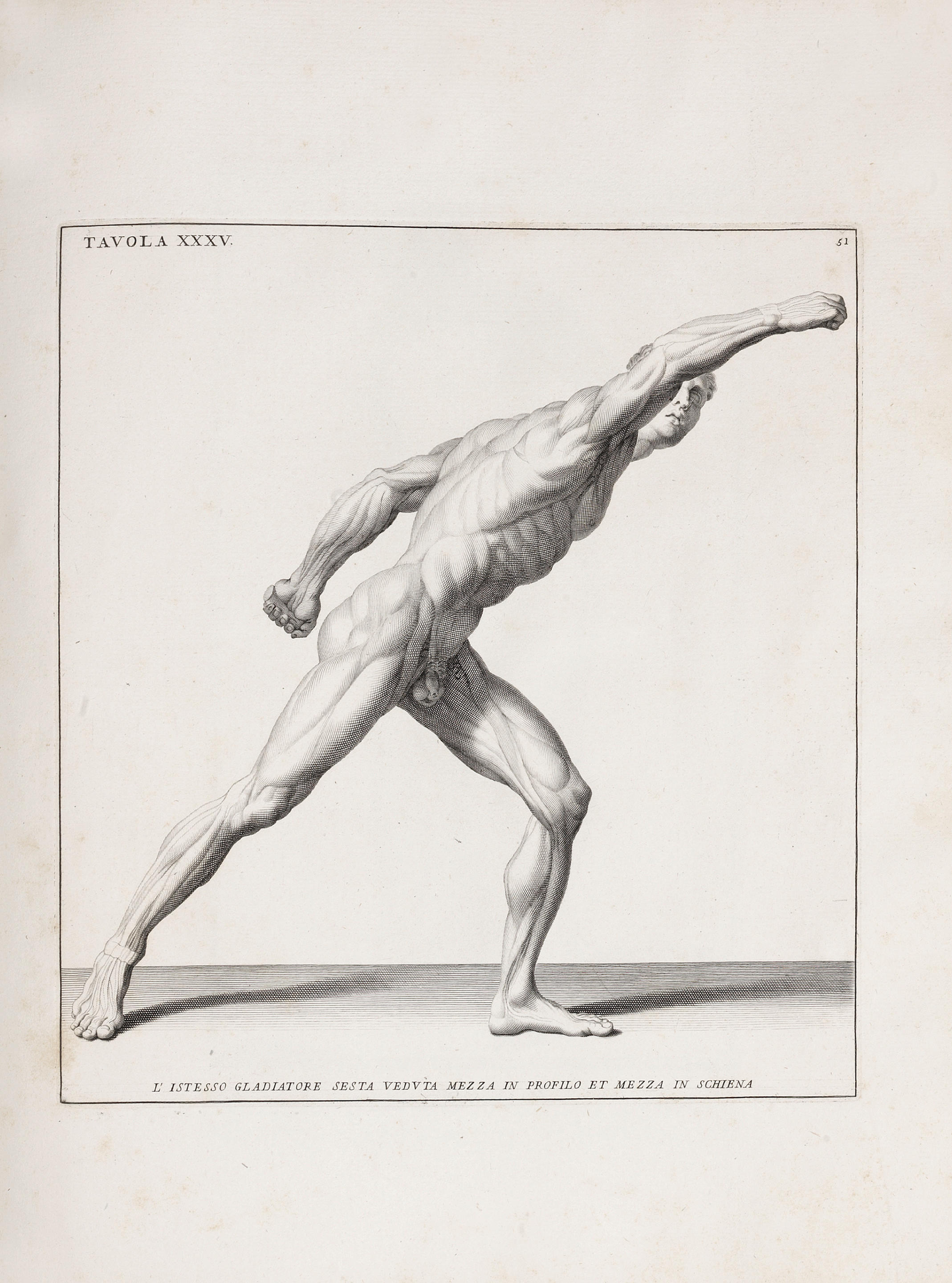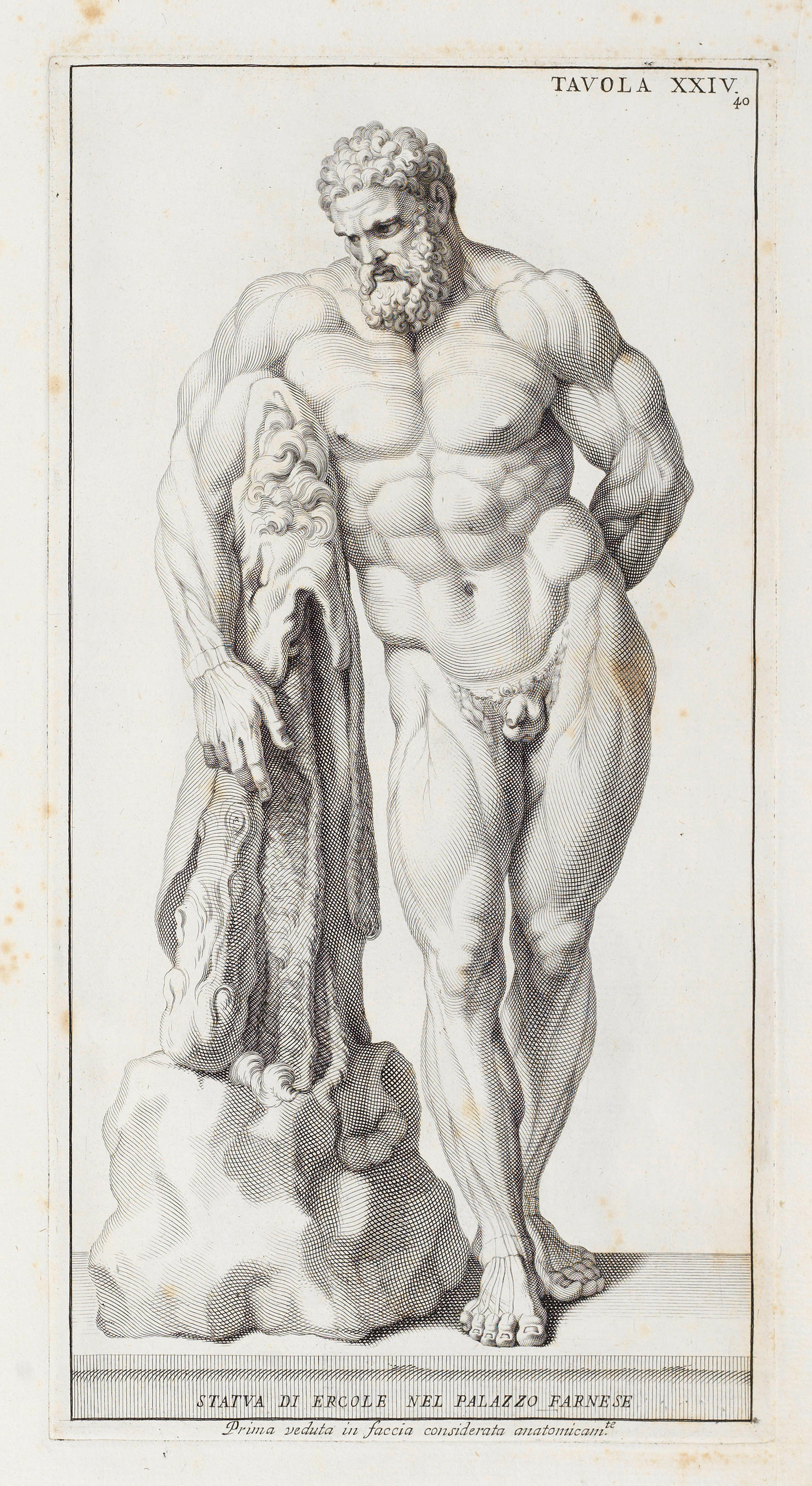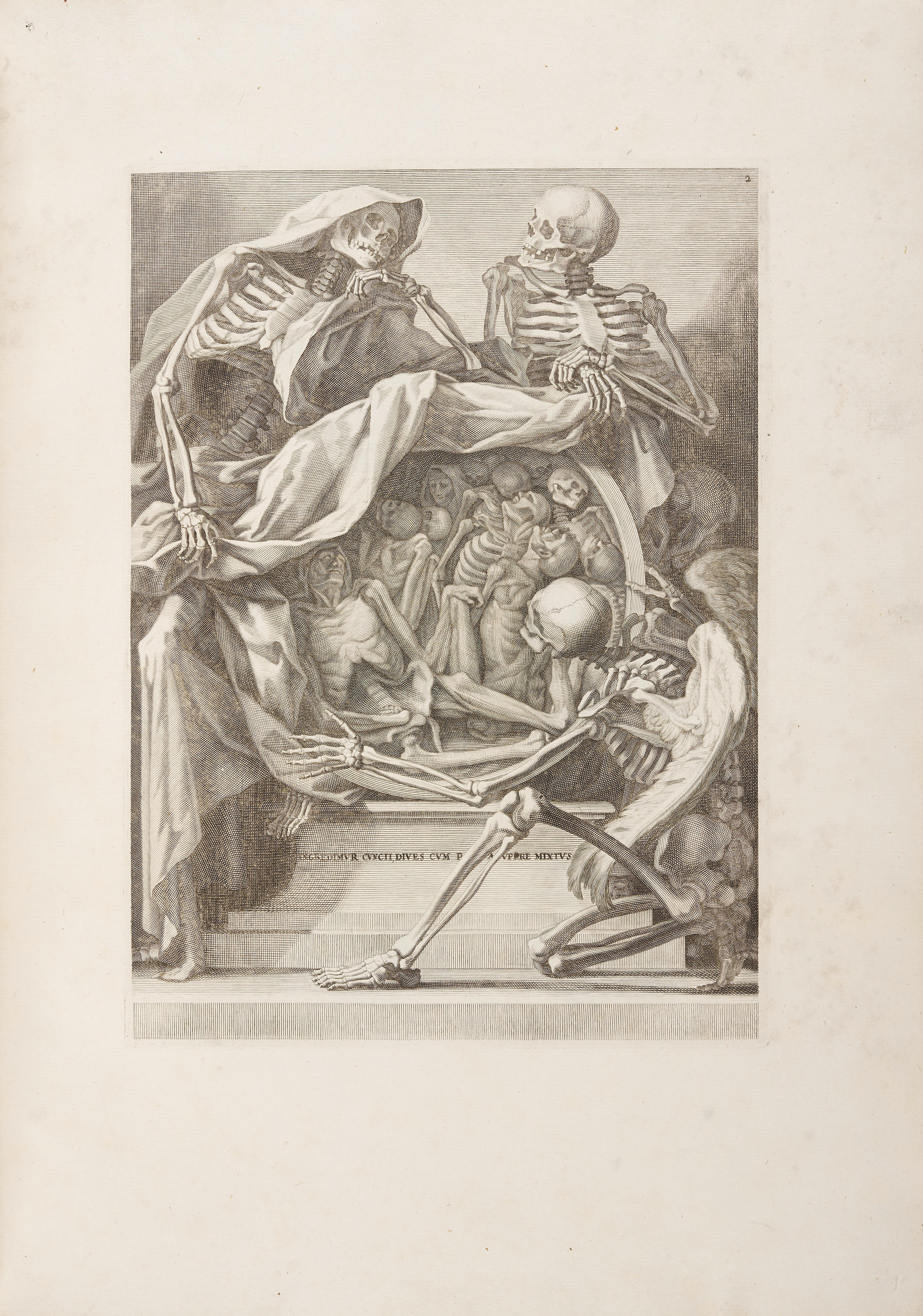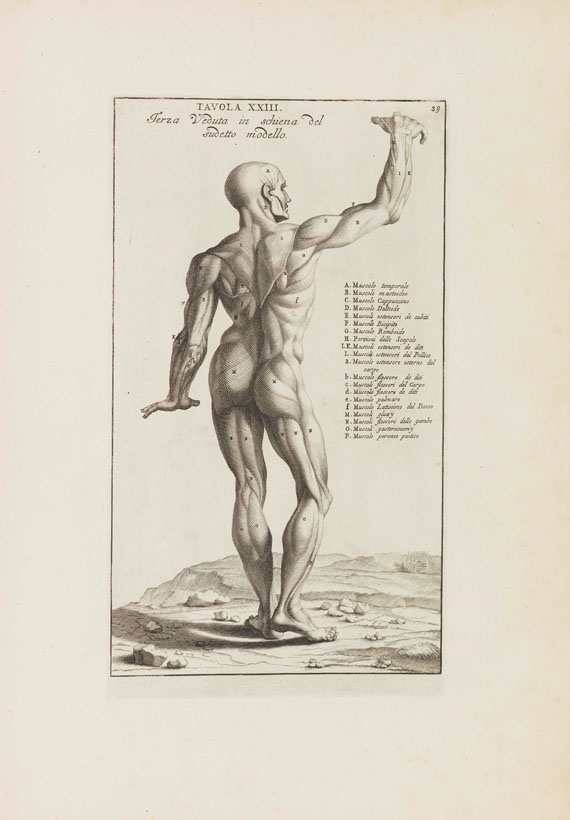GENGA, Bernardino (1620-1690). Anatomia per uso et intelligenza del disegnoricercata non solo su gl'ossi, e muscoli del corpo humano; ma dimostrata ancora su le statue antiche piu insigni di Roma . Edited and with commentary by Giovanni Maria Lancisi (1654-1720). Rome: Domenico de Rossi 1691.
GENGA, Bernardino (1620-1690). Anatomia per uso et intelligenza del disegnoricercata non solo su gl'ossi, e muscoli del corpo humano; ma dimostrata ancora su le statue antiche piu insigni di Roma . Edited and with commentary by Giovanni Maria Lancisi (1654-1720). Rome: Domenico de Rossi 1691. 2 o (472 x 318 mm). 56 leaves, engraved throughout. Title, frontispiece, 15 tables and indices (printed on rectos only), 40 fine plates probably by François Andriot after designs by Charles Errard (Small adhesion on title border, occasional pale marginal spotting.) Contemporary gilt-paneled Dutch vellum (front joint split, some pale staining). Provenance : Richard Ker (signature on flyleaf); acquired through Arthur Freeman, Sotheby's London, 21 July 1970, lot 576. FIRST EDITION OF ONE OF THE FINEST ANATOMY BOOKS FOR ARTISTS. This work was originated by the French artist, Charles Errard (ca 1606-89), a court painter to Louis XIV, who helped found the Académie Royale de Peinture, and was the first director of the French Academy in Rome. Errard drew the famous frontispiece depicting emaciated corpses in a roundel, surrounding which are three skeletons, and probably also drew some or all of the plates of classical statuary. However, he left the project unfinished. Genga, who was teaching anatomy to artists at the French Academy, took up Errard's unfinished project, and completed the dissections. The papal physician Giovanni Maria Lancisi (1654-1720) wrote the explanations for the plates and supplied the index. The plates were probably engraved by the Parisian engraver François Andriot (or Handeriot) (d. 1704). Thus, even though the book was as much a French project as Italian, and Genga was responsible for only a relatively small portion, the work was published under Genga's name the year after Genga's death. "The most outstanding feature [of the book] is the presentation of a series of plates of famous antique statues 'considered anatomically.' Presented as if flayed and in several views are the Farnes Hercules (plates 24-26), the central figure from the Laocoön group (plates 27-29), the Borghese Gladiator (plates 30-35), and variations on a figure identified with the Borghese Faun (plates 36-39), now in the Louvre and also known as Silenus with the Infant Bacchus " (Cazort, Kornell, Roberts, The Ingenious Machine of Nature: Four Centuries of Art and Anatomy , [1996], p. 217.) Choulant-Frank, pp. 254-55; Garrison-Morton 386; Heirs of Hippocrates 531; NLM/Krivatsy 4655 (variant issue of title-page with "libro primo" on title [but all published], as the Norman copy); Norman 888; Sappol, Dream Anatomy p. 134; Waller 5540; Wellcome III, pp. 102-03. [ Bound with :] GRACHT, Jacob van der (1593-1652). Anatomie der uuterlicke deelen van het menschelick lichaem Bequaem voor schiklders, beelt-houwers, plaetsnyders, als oock chirurgiens . The Hague: By the Author, 1634. 2 o (378 x 233 mm; inlaid into larger sheets uniform in size with the preceding). Engraved title and 18 full-page skeletal and muscle engravings, the first two unnumbered, the remaining numbered 1-16. (Some pale soiling.) FIRST EDITION. Choulant considered this, and not Genga's work, to be the earliest independent work of anatomy intended for graphic or plastic artists. The painter, engraver and writer Van der Gracht worked in Italy, studying anatomy there and even dissecting cadavers to get a thorough knowledge of the relations of the parts of the body. All but two of the engravings are careful derivations from Vesalius, and correct two of Vesalius' most serious errors: the scalenus muscle and rectus abdominis. He made his muscles more prominent than Vesalius and "achieved conspicuous success in showing the relation of the muscles to the bony skeleton" (Cushing VI. D.16, p. 138). The title shows an anatomy lesson for artists with a cadaver suspended in the sitting position Vesalius used when demonstrating to artists. Not in Bartsch, Norman, Osler, Waller or Wellcome. Choulant
GENGA, Bernardino (1620-1690). Anatomia per uso et intelligenza del disegnoricercata non solo su gl'ossi, e muscoli del corpo humano; ma dimostrata ancora su le statue antiche piu insigni di Roma . Edited and with commentary by Giovanni Maria Lancisi (1654-1720). Rome: Domenico de Rossi 1691.
GENGA, Bernardino (1620-1690). Anatomia per uso et intelligenza del disegnoricercata non solo su gl'ossi, e muscoli del corpo humano; ma dimostrata ancora su le statue antiche piu insigni di Roma . Edited and with commentary by Giovanni Maria Lancisi (1654-1720). Rome: Domenico de Rossi 1691. 2 o (472 x 318 mm). 56 leaves, engraved throughout. Title, frontispiece, 15 tables and indices (printed on rectos only), 40 fine plates probably by François Andriot after designs by Charles Errard (Small adhesion on title border, occasional pale marginal spotting.) Contemporary gilt-paneled Dutch vellum (front joint split, some pale staining). Provenance : Richard Ker (signature on flyleaf); acquired through Arthur Freeman, Sotheby's London, 21 July 1970, lot 576. FIRST EDITION OF ONE OF THE FINEST ANATOMY BOOKS FOR ARTISTS. This work was originated by the French artist, Charles Errard (ca 1606-89), a court painter to Louis XIV, who helped found the Académie Royale de Peinture, and was the first director of the French Academy in Rome. Errard drew the famous frontispiece depicting emaciated corpses in a roundel, surrounding which are three skeletons, and probably also drew some or all of the plates of classical statuary. However, he left the project unfinished. Genga, who was teaching anatomy to artists at the French Academy, took up Errard's unfinished project, and completed the dissections. The papal physician Giovanni Maria Lancisi (1654-1720) wrote the explanations for the plates and supplied the index. The plates were probably engraved by the Parisian engraver François Andriot (or Handeriot) (d. 1704). Thus, even though the book was as much a French project as Italian, and Genga was responsible for only a relatively small portion, the work was published under Genga's name the year after Genga's death. "The most outstanding feature [of the book] is the presentation of a series of plates of famous antique statues 'considered anatomically.' Presented as if flayed and in several views are the Farnes Hercules (plates 24-26), the central figure from the Laocoön group (plates 27-29), the Borghese Gladiator (plates 30-35), and variations on a figure identified with the Borghese Faun (plates 36-39), now in the Louvre and also known as Silenus with the Infant Bacchus " (Cazort, Kornell, Roberts, The Ingenious Machine of Nature: Four Centuries of Art and Anatomy , [1996], p. 217.) Choulant-Frank, pp. 254-55; Garrison-Morton 386; Heirs of Hippocrates 531; NLM/Krivatsy 4655 (variant issue of title-page with "libro primo" on title [but all published], as the Norman copy); Norman 888; Sappol, Dream Anatomy p. 134; Waller 5540; Wellcome III, pp. 102-03. [ Bound with :] GRACHT, Jacob van der (1593-1652). Anatomie der uuterlicke deelen van het menschelick lichaem Bequaem voor schiklders, beelt-houwers, plaetsnyders, als oock chirurgiens . The Hague: By the Author, 1634. 2 o (378 x 233 mm; inlaid into larger sheets uniform in size with the preceding). Engraved title and 18 full-page skeletal and muscle engravings, the first two unnumbered, the remaining numbered 1-16. (Some pale soiling.) FIRST EDITION. Choulant considered this, and not Genga's work, to be the earliest independent work of anatomy intended for graphic or plastic artists. The painter, engraver and writer Van der Gracht worked in Italy, studying anatomy there and even dissecting cadavers to get a thorough knowledge of the relations of the parts of the body. All but two of the engravings are careful derivations from Vesalius, and correct two of Vesalius' most serious errors: the scalenus muscle and rectus abdominis. He made his muscles more prominent than Vesalius and "achieved conspicuous success in showing the relation of the muscles to the bony skeleton" (Cushing VI. D.16, p. 138). The title shows an anatomy lesson for artists with a cadaver suspended in the sitting position Vesalius used when demonstrating to artists. Not in Bartsch, Norman, Osler, Waller or Wellcome. Choulant




.jpg)









Try LotSearch and its premium features for 7 days - without any costs!
Be notified automatically about new items in upcoming auctions.
Create an alert